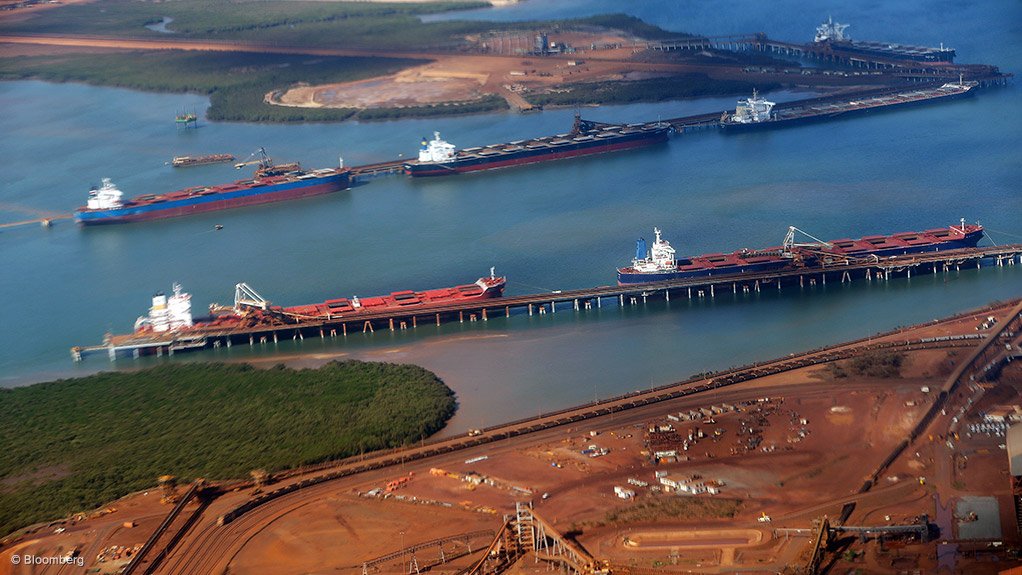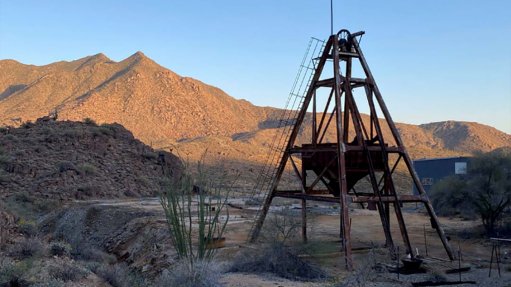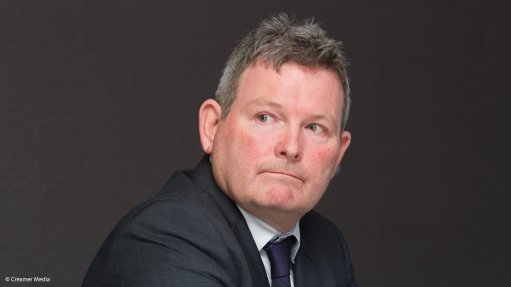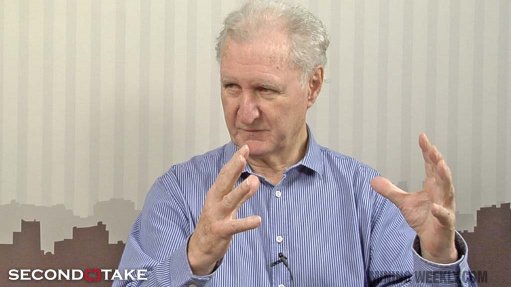Waning interest in African greenfield iron-ore projects


INVESTOR INTEREST West African iron-ore projects that have clear and short-term access to the iron-ore market continue to attract attention
Photo by Bloomberg
Surging growth in demand for iron-ore from China drove prices up during the early 2010’s, which led to a significant upswing in greenfield exploration programmes, which were largely high-grade direct shipping ore (DSO) projects in West Africa.
However, mining consultancy MSA Group head of geology Dr Brendan Clarke says iron-ore prices have dropped in the last few months to well below $100/t, with the result being a rapid and noticeable decrease in investor interest in greenfield exploration, particularly the high-grade DSO projects – almost all of which are a significant distance from port and rail infrastructure.
Nevertheless, MSA Group MD Keith Scott feels that the success of Aim-listed mining company African Minerals’ Tonkolili iron-ore project, in Sierra Leone, has demonstrated that differentiated iron-ore projects may be able to withstand current prices. “Several developers are still committed to bringing their projects to account.”
Scott stresses that projects need to have a combination of clear differentiators to be successful. These differentiators include low costs, good grades and/or good quality orebodies, better logistics than those of competitors, lower-cost stable energy solutions, political stability, transparency, established and tested mining codes and regulatory certainty, as well as government efficiency in dealing with projects.
“While West Africa remains one of the largest undeveloped iron-ore regions globally, and iron-ore projects will be developed eventually, significant development in the region will take decades and generations.”
He notes the announcement last month by diversified miner Exxaro of the writedown of its investment in the Mayoko project in the Republic of Congo. “They have indicated that they will only be in a position to advance the project once favourable rail and port solutions are found. While the project may still be developed, it highlights the commercial and technical challenges and complexities of developing new projects in jurisdictions in which there are no precedents.”
China, however, remains actively involved in iron-ore and related infrastructure development in West Africa, disrupting the market dominance of the big three producers – Vale, BHP Billiton and Rio Tinto. Scott notes that steel production in China is increasing and is expected to peak at about 880-million tonnes a year in 2017.
He adds that, while China produces the bulk of its iron-ore requirements, its projects entail producing low-grade ore, which is expensive to mine and, in many cases, expensive to transport to China’s industrial and beneficiation zones, primarily situated at its coastal areas.
“Further, China’s new political leadership is determined to decrease carbon dioxide emissions and may pass directives to steel producers to do so – it will even demand that production be curtailed to achieve this,” says Scott.
Nevertheless, Clarke adds that West African iron-ore projects with clear and short-term access to the iron-ore market are still valued by global investors and continue to attract interest.
Project Opportunity
Clarke tells Mining Weekly that, while DSO projects close to the coast and situated adjacent to infrastructure are “the ultimate first prize”, magnetite projects near current and planned deep-water ports are also attracting interest.
“Depending on the metallurgical characteristics of the magnetite ores, a saleable concentrate could be produced at a comparatively low cost, which is certainly less than the cost of developing infrastructure required for transporting DSO to port from an inland location,” he adds.
Therefore, there is interest in several Cameroon-based projects, owing to the development of the Lolabe port, says Clarke. He cites the International Mining & Infrastructure Corporation’s recent acquisition of Cameroon mining company Afferro Mining’s projects, which are predominantly near coastal magnetite. Indian steel major Jindal Steel also acquired the magnetite gneiss project in Ngovayang, in north- central Cameroon, from mining company Legend Resources.
Further, exploration company West African Minerals continues work on its Binga project, which is about 80 km from the Kribi deep-water port, in south-west Cameroon, and comprises magnetite gneiss which, according to metallurgical testwork, can potentially be upgradeable to a saleable product, notes Clarke.
He adds that similar projects exist along the coastline of Central and West Africa and are contingent on the development of port infrastructure.
Meanwhile, Scott believes the best way for West Africa to ensure the sustainable development of its iron-ore projects is to offer potential investors long-term political stability, transparency and guaranteed legislative enforcement.
“West Africa should also offer a good regulatory and commercial environment to assure investors that they will recover their capital and make a profit relative to the risks they are taking in the long term,” he says.
Market Challenges
Clarke highlights that the availability of and access to infrastructure remains a burden to the iron-ore industry.
He explains that unlocking isolated DSO projects in the middle of the rainforest, for instance, will require significant capital investment, such as railway lines and deep-water port and loading facilities.
“We believe that such development will most likely be realised through explorer collaboration, which would require a complete amalgamation of these projects through a buyout by a major mining company or, possibly, significant State-funded intervention.”
Clarke adds that, compared with projects in Australia’s Pilbara region, Africa also faces significant capital expenditure challenges in terms of developing the necessary infrastructure. He notes that infrastructure in Pilbara is well established, fully paid for and is closer to the Chinese market.
“However, African projects do have significant operational expenditure advantages in terms of lower labour costs and, in many cases, lower royalty or super-tax rates,” he says.
Clarke further notes that the growing global steel demand is being met by the supply of recycled ferrous scrap metal, adding that recycled scrap accounted for about a third of global steel demand in 2012.
“The sharp increase in the recycling of ferrous scrap in the last few years has been driven by the globalisation of the scrap industry, including the increased involvement of Chinese players. This increase in scrap metal supply places less impetus on the discovery of new iron-ore deposits.”
Clarke concludes that opportunity for iron-ore projects remains, particularly as several export restrictions on scrap metal trading do not appear to be easing.
Comments
Press Office
Announcements
What's On
Subscribe to improve your user experience...
Option 1 (equivalent of R125 a month):
Receive a weekly copy of Creamer Media's Engineering News & Mining Weekly magazine
(print copy for those in South Africa and e-magazine for those outside of South Africa)
Receive daily email newsletters
Access to full search results
Access archive of magazine back copies
Access to Projects in Progress
Access to ONE Research Report of your choice in PDF format
Option 2 (equivalent of R375 a month):
All benefits from Option 1
PLUS
Access to Creamer Media's Research Channel Africa for ALL Research Reports, in PDF format, on various industrial and mining sectors
including Electricity; Water; Energy Transition; Hydrogen; Roads, Rail and Ports; Coal; Gold; Platinum; Battery Metals; etc.
Already a subscriber?
Forgotten your password?
Receive weekly copy of Creamer Media's Engineering News & Mining Weekly magazine (print copy for those in South Africa and e-magazine for those outside of South Africa)
➕
Recieve daily email newsletters
➕
Access to full search results
➕
Access archive of magazine back copies
➕
Access to Projects in Progress
➕
Access to ONE Research Report of your choice in PDF format
RESEARCH CHANNEL AFRICA
R4500 (equivalent of R375 a month)
SUBSCRIBEAll benefits from Option 1
➕
Access to Creamer Media's Research Channel Africa for ALL Research Reports on various industrial and mining sectors, in PDF format, including on:
Electricity
➕
Water
➕
Energy Transition
➕
Hydrogen
➕
Roads, Rail and Ports
➕
Coal
➕
Gold
➕
Platinum
➕
Battery Metals
➕
etc.
Receive all benefits from Option 1 or Option 2 delivered to numerous people at your company
➕
Multiple User names and Passwords for simultaneous log-ins
➕
Intranet integration access to all in your organisation



















